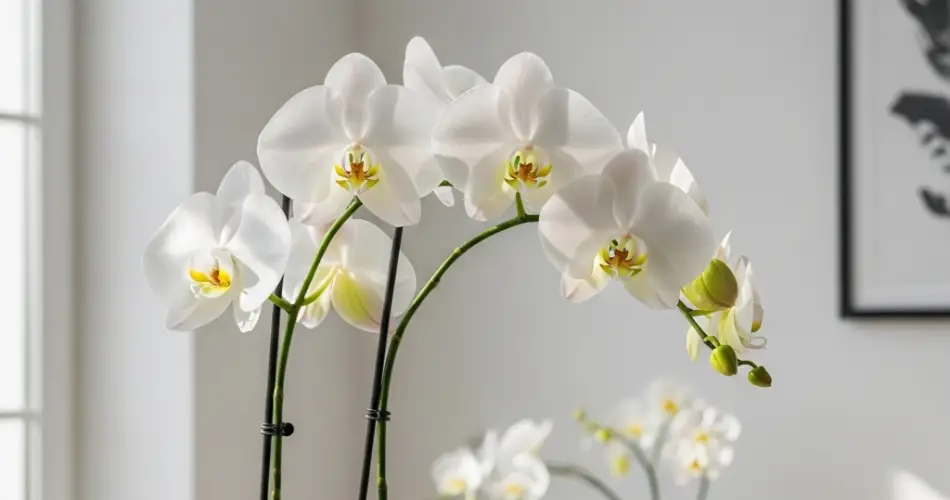Orchids are among the most elegant and rewarding indoor plants, admired for their exotic blooms and graceful structure. While they may have a reputation for being finicky, orchids are actually quite manageable when you understand their needs. With the right environment and consistent care, you can enjoy vibrant flowers that last for weeks—or even months—on end.
Whether you’re a beginner or a seasoned houseplant enthusiast, these indoor orchid care tips will help your orchids thrive year-round.
1. Choose the Right Orchid Variety
The most commonly grown orchid indoors is the Phalaenopsis or moth orchid. It’s ideal for beginners thanks to its resilience, long-lasting flowers, and adaptability to indoor environments. Other popular varieties include Dendrobium, Cattleya, and Oncidium, though they may have slightly different care requirements.
Tip: Start with Phalaenopsis if you’re new to orchids, then explore other types once you’re more confident in your care routine.
2. Provide Bright, Indirect Light
Orchids love light, but not direct sunlight. In their natural habitat, they grow under the canopy of trees, receiving filtered light. Indoors, aim to place them near an east- or west-facing window where they can get bright but indirect light.
Tip: If your orchid’s leaves are dark green, it may not be getting enough light. Yellowish-green or slightly red-tinted leaves indicate optimal light exposure. Avoid hot afternoon sun, which can scorch the leaves.
3. Maintain the Right Temperature and Humidity
Orchids prefer temperatures between 65°F and 80°F (18°C–27°C) during the day and slightly cooler at night. They also thrive in humidity levels of around 50% to 70%. Low humidity can cause buds to drop and leaves to wrinkle.
Tip: Use a humidity tray or a room humidifier if your home is particularly dry. Grouping plants together can also create a microclimate with higher humidity.
4. Water Properly
Improper watering is one of the most common reasons orchids struggle. These plants don’t like to sit in water but do need consistent moisture.
Tip: Water thoroughly once a week, allowing water to drain completely from the pot. Never let the pot sit in standing water. Stick your finger about an inch into the potting medium—if it feels dry, it’s time to water. Avoid watering the crown (center) of the plant, as this can lead to rot.
5. Use the Right Potting Medium
Orchids require a loose, well-draining medium—standard potting soil will suffocate the roots. Most orchids grow best in bark, sphagnum moss, coconut husk chips, or a blend of these.
Tip: Choose a potting mix specifically labeled for orchids. Repot every 1–2 years to refresh the medium and prevent root rot.
6. Fertilize Lightly and Regularly
Orchids are light feeders, but they do benefit from regular feeding during active growth. Use a balanced orchid fertilizer (such as 20-20-20) diluted to half strength.
Tip: Fertilize every two weeks during the growing season (spring and summer), and reduce to once a month in fall and winter. Always water before applying fertilizer to avoid burning the roots.
7. Encourage Reblooming
Orchids can rebloom with a little care and patience. After flowering, don’t toss your orchid—most varieties, especially Phalaenopsis, can bloom again from the same spike.
Tip: Once the flowers fall off, trim the spike just above a node (small bump) to encourage a new flower spike. If the spike turns brown, cut it back to the base to allow the plant to rest before producing a new one.
8. Provide Good Air Circulation
Stagnant air can lead to fungal problems and pest infestations. Good airflow helps orchids stay healthy and disease-free.
Tip: Place a small fan nearby or open a window occasionally. Just avoid placing orchids in drafty areas with harsh temperature fluctuations.
9. Watch for Pests and Diseases
Orchids are generally pest-resistant but can occasionally be affected by mealybugs, scale, spider mites, or fungus. Catching issues early makes treatment easier.
Tip: Inspect leaves, stems, and potting medium regularly. Use insecticidal soap or neem oil for minor infestations. Remove any affected parts and isolate the plant if needed.
10. Be Patient and Observant
Orchids grow slowly and may not show immediate results after care adjustments. Observing your plant and understanding its signals is key to long-term success.
Tip: Keep a simple journal of watering, fertilizing, and flowering periods. This can help you spot patterns and better meet your orchid’s needs over time.
Final Thoughts
Orchids may look exotic and delicate, but with the right care, they can become one of the most rewarding indoor plants. By focusing on proper light, watering, humidity, and feeding, you’ll encourage healthy growth and repeated blooms. Treat each orchid as a unique plant with individual needs, and you’ll be amazed at how often it rewards you with stunning, long-lasting flowers.



